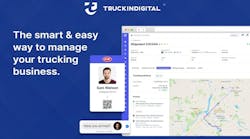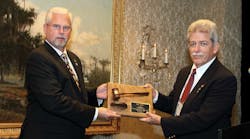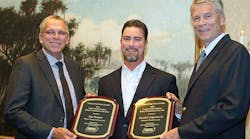LABOR union membership has declined steadily since 1983, but unions have become “increasingly creative and aggressive in how they recruit and organize,” according to J Allen Jones Benesch, an attorney for Friedlander Coplan & Aronoff LLP.
In 2014, there were more than three million fewer union members than in 1983. And union membership declined from 2013-2014 by 0.2%.
“That may not seem like a significant number, but it really is when you consider only 6.5% of the workforce is union members, and most of that is in the public sector,” he said June 10 during the National Tank Truck Carriers Tank Truck Safety & Security Council Annual Meeting in New Orleans, Louisiana.
Despite the continuous trend, labor unions haven’t given up on the private sector. Most ominously, Big Labor is getting plenty of help from the Department of Labor, specifically the National Labor Relations Board (NLRB).
“For example, throughout the United States, and most recently in Los Angeles, labor unions are driving efforts to increase the minimum wage,” Benesch said. “However, while pressing for minimum-wage increases, the unions are exempting themselves from wage increases imposed on non-union employers, then marketing themselves to non-union employers as a way to decrease wage expense. In other words, ‘Let us organize your employees and you won’t have to pay them a higher wage.’
“That’s great for the employers, great for the unions, but not so great for the employees. But the labor unions can theoretically increase their membership, which is relied upon to fund the unions’ activities and operations.”
He said unions have seized on another opportunity to increase their membership rolls. In April, new federal rules governing union elections—“Quickie” or “Ambush” election rules—took effect.
“In short, the new rules are designed to make union organizing campaigns easier, and severely hamstring employers’ ability to respond,” he said. “Election petitions, notices, and voter lists can now be submitted electronically. Employers and employees will now receive more detailed information regarding the NLRB’s procedures, issues for the pre-election hearing, rights and obligations, and the voting process.
“Pre-election hearings will begin eight days after service of a hearing notice and post-election hearings 14 days after objections are filed. Employers’ Statements of Positions are due one day before the pre-election hearing and must identify all issues the employer wants to litigate before the election. Employers must provide a list of prospective voters, with job classifications, shifts, and work locations, to the NLRB and other parties with the Statement of Position. This is a significant additional administrative burden for the employer, who is already scrambling to respond. The pre-election hearing is limited to whether an election is appropriate. Any extraneous issues, like voter eligibility, are deferred until after the election.
“The pre-election hearing will conclude with an oral argument, and a written briefing is no longer allowed without permission of the regional NLRB director. Elections are no longer stayed in the event of a request to review a decision by the regional NLRB director. The NLRB is no longer required to review all post-election disputes. It can deny review at its discretion. Voter lists must be submitted within two business days of the approval of an election agreement or decision regarding an election. The voter list must also include personal phone numbers and email addresses if available.”
Peter N Kirsanow, an attorney for Friedlander Coplan & Aronoff LLP, said the ruling in Specialty Healthcare and Rehabilitation Center of Mobile, 357 NLRB #83 (August 26, 2011) has fundamentally altered how bargaining units are determined.
“For 75 years, if I’m Jimmy Hoffa Jr, and I want to represent the ABC Trucking Company workforce, I’d have to get 51% of everybody in the place to vote in my favor,” Kirsanow said. “The presumption always was that a bargaining unit must be wall-to-wall. I’d have to convince 50% plus one of you to vote in favor of my union, and I’d have to get 30% just to sign enough cards so I could even have an election. That’s a tough proposition.
“Under Specialty Healthcare, I no longer have to do that. I just have to find two of you who work in the same location and have the same job classification, and I can get you unionized. And I can forget about rest of you for now.
“So long as the union’s petitioned-for unit consists of a clearly identifiable group, that unit is presumed appropriate unless the employer can establish that a larger group shares an overwhelming community of interest. For decades, the rule had been that employees sharing a community of interest should be in the same unit. In a typical manufacturing setting, this resulted in units of all production and maintenance employees.
“Now, only if the community of interest is overwhelming will the unit be expanded from what the union wants. That has led to unions getting units they want.”
He said the impact of Specialty Healthcare means:
• Smaller units such as departments or job classifications are now possible.
• Unions are now enabled to focus organizational efforts toward small groups where it has support.
• Unions are now allowed to get a “foot in the door” and expand from the inside.
• A small group can become a disruptive force.
He said that under the new NLRB election rules, there is a hearing seven days from the filing of a petition, compared to previously being seven to 14 days.
“Eligibility issues need not be litigated before elections,” he said. “There are post-hearing briefs only with the special permission of RD.
“In the Statement of Position on issues, the employer must know its position and submit it in writing prior to the start of the hearing. Failure to raise an issue amounts to a waiver. If a party contends the proposed unit is not appropriate, the party must state what would make the unit appropriate. It may be e-filed. There are postponements up to two days upon showing of extraordinary circumstances.
“On the final voter eligibility list, electronic submission is two days after a unit determination is made.
The backloading of post-election issues:
• 20% Rule: Up to 20% of a unit may vote subject to challenge.
• It would become discretionary, leaving regional directors with the final word on most issues.
• Litigating supervisory status pre-election is discretionary with the regional director.
• Litigating status of confidential employees may be deferred.
• Litigating status of temporary employees may be deferred. ♦
View more 2015 NTTC Safety Conference coverage >
Find the NTTC Safety Conference archive with articles from 2012 to present










